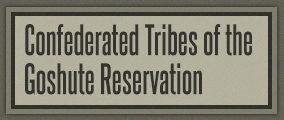Demography
Brief History
According to the Goshutes, their people have always lived in the desert region southwest of the Great Salt Lake. Scientists argue that the Goshute Indians migrated along with other Numic-speaking peoples from the Death Valley region of California to the Great Basin, probably around one thousand years ago. The Goshute people occupied some of the most arid land in North America. As highly efficient hunters and gatherers, they maintained the fragile balance of the desert, providing for their needs without destroying the limited resources of their arid homeland. For the most part they lived in family units, but larger groups would sometimes come together to hunt.
For a time, the harsh desert conditions of the Goshutes’ territory provided an effective barrier against white encroachment, although the Goshutes did encounter transient trappers, emigrants, and slave traders. The Goshute were not, however, unaffected by Spanish settlement of New Mexico, as they were the frequent victims of slave raids.
Major white settlement began in the 1850s with the arrival of the Mormons. Permanent settlements encroached upon Goshute lands and resources, upsetting the careful ecological balance the Indians had cultivated and resulting in conflict between Mormons and the Goshutes. Between 1864 and 1912, federal authorities undertook efforts to remove the Goshutes, but when these attempts failed, the Goshutes received reservation land in their native Utah. The Skull Valley Reservation was created in 1912, and the Deep Creek Reservation was formed in 1914.
The creation of reservations ensured the Goshutes ownership of their traditional homeland, but the reservations also brought Indian agents and federal employees with the mission of reordering Goshute life along a white model. The Goshutes, who had always been extremely skilled and efficient in their use of wild plants, took up farming as early as the 1860s. In the reservation period, federal agents promoted agriculture as a means of “civilizing” the Goshutes, but their desert lands generally could not support self-sufficient farming.
In the second half of the twentieth century, lack of economic opportunity led the Goshutes to seek outside development. The Deep Creek Band currently manages an elk herd, and profits from the sale of hunting permits go back to the tribe. In 1976 the Skull Valley Band of Goshutes built a rocket motor testing facility, which it leases to Hercules, Inc. The Skull Valley Band also pursued the development of a storage facility for spent fuel rods from nuclear power plants. This controversial project was opposed by the governor of Utah, environmental groups, and the Deep Creek Band of Goshutes.
Language and Culture
The Goshute Indians are part of the larger Shoshonean (Numic) speaking groups that live in the Intermountain West; whether speaking individually or collectively they all refer to each other as Newe (the People), considering themselves still connected by an ancient common ancestry. On both of the Goshute reservations, however, the people feel the language is slowly being lost. On the Deep Creek Reservation, most of the youth ages 18 and under do not speak the native language, and only one in twenty between the ages of 19 and 26 speak it. Most of the tribal members over 26, however, do speak the language and continue to keep it alive.
Many of their native religious ceremonies and practices have been retained; however, because of the scarcity of resources in their homeland the Goshute have few ceremonies in comparison with other Great Basin Indian groups. The round dance was known and primarily used to obtain assistance in making seeds grow; less frequently it was used as a social dance.
Education is important to all tribal members living on both reservations. They believe it is an essential element for improvement on the reservations and for their people. Education is difficult for them; with no school on the reservations or nearby, many children must be bused to Wendover for their schooling, a 120 mile round trip. Negotiations are in the works to build a school on the Deep Creek Reservation to better accommodate the children of the tribe.





